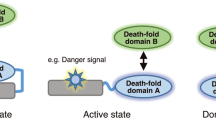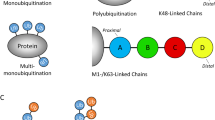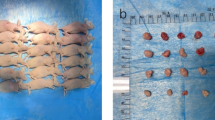Abstract
TNFR1 associated death domain protein (TRADD) contains an N-terminal TRAF binding domain and a C-terminal death domain along with nuclear import and export sequences that cause shuttling between the cytoplasm and nucleus. The death domain of TRADD contains the nuclear import sequence and expression of the core death domain (nuclear TRADD) results in exclusive nuclear localization and activation of a distinct apoptotic pathway. Cytoplasmic TRADD activates apoptosis through Fas-associated death domain protein (FADD) and caspase-8 activation that was blocked by caspase inhibitors or dominant-negative FADD. These inhibitors did not inhibit death induced by nuclear TRADD, which could only be inhibited by combining caspase inhibitors and a serine protease inhibitor. The pathway activated by nuclear TRADD requires caspase-9 catalytic activity. However, apoptosis activating factor deficiency confers only partial protection from death. This pathway represents an alternate means by which TRADD can regulate cell death independently of FADD and caspase-8 that occurs from the nucleus rather than the cytoplasm.
Similar content being viewed by others
Log in or create a free account to read this content
Gain free access to this article, as well as selected content from this journal and more on nature.com
or
Abbreviations
- AEBSF:
-
(4-(2-Aminoethyl)benzenesulfonyl fluoride hydrochloride)
- APAF-1:
-
apoptosis activating factor I
- FADD:
-
Fas associated death domain protein
- FADD-DD:
-
dominant-negative FADD
- IAP:
-
inhibitor of apoptosis protein
- ICR-191:
-
6-Chloro-9[3-(2-chloroethylamino)propylamino]-2-methyoxyacridine
- MEFs:
-
mouse embryonic fibroblasts
- siRNA:
-
short interfering RNA
- PARP:
-
poly(ADP-ribose) polymerase
- Stat-1:
-
signal transducer and activator of transcription I
- TNFR:
-
TNF receptor
- TRADD:
-
TNFR1 associated death domain protein
- YFP:
-
yellow fluorescent protein
- zVAD.fmk:
-
N-Benzyloxcarbonyl-Val-Ala-Asp(o-Me) fluoromethyl ketone
References
Hengartner MO (2000) The biochemistry of apoptosis. Nature 407: 770–776
Budihardjo I, Oliver H, Lutter M, Luo X and Wang X (1999) Biochemical pathways of caspase activation during apoptosis. Annu. Rev. Cell Dev. Biol. 15: 269–290
Ashkenazi A and Dixit VM (1999) Apoptosis control by death and decoy receptors. Curr. Opin. Cell Biol. 11: 255–260
Thorburn A (2004) Death receptor-induced cell killing. Cell. Signal. 16: 139–144
Luo X, Budihardjo I, Zou H, Slaughter C and Wang X (1998) Bid, a Bcl2 interacting protein, mediates cytochrome c release from mitochondria in response to activation of cell surface death receptors. Cell 94: 481–490
Leist M and Jaattela M (2001) Four deaths and a funeral: from caspases to alternative mechanisms. Nat. Rev. Mol. Cell Biol. 2: 589–598
Johnson DE (2000) Noncaspase proteases in apoptosis. Leukemia 14: 1695–1703
Leist M and Jaattela M (2001) Triggering of apoptosis by cathepsins. Cell Death Differ. 8: 324–326
Martins LM, Iaccarino I, Tenev T, Gschmeissner S, Totty NF, Lemoine NR, Savopoulos J, Gray CW, Creasy CL, Dingwall C and Downward J (2002) The serine protease Omi/HtrA2 regulates apoptosis by binding XIAP through a Reaper-like motif. J. Biol. Chem. 277: 439–444
Hegde R, Srinivasula SM, Zhang Z, Wassell R, Mukattash R, Cilenti L, DuBois G, Lazebnik Y, Zervos AS, Fernandes-Alnemri T and Alnemri ES (2002) Identification of Omi/HtrA2 as a mitochondrial apoptotic serine protease that disrupts IAP-caspase interaction. J. Biol. Chem. 277: 432–438
van Loo G, van Gurp M, Depuydt B, Srinivasula SM, Rodriguez I, Alnemri ES, Gevaert K, Vandekerckhove J, Declercq W and Vandenabeele P (2002) The serine protease Omi/HtrA2 is released from mitochondria during apoptosis. Omi interacts with caspase-inhibitor XIAP and induces enhanced caspase activity. Cell Death Differ. 9: 20–26
Srinivasula SM, Gupta S, Datta P, Zhang Z, Hegde R, Cheong N, Fernandes-Alnemri T and Alnemri ES (2003) Inhibitor of apoptosis proteins are substrates for the mitochondrial serine protease Omi/HtrA2. J. Biol. Chem. 278: 31469–31472
Yang QH, Church-Hajduk R, Ren J, Newton ML and Du C (2003) Omi/HtrA2 catalytic cleavage of inhibitor of apoptosis (IAP) irreversibly inactivates IAPs and facilitates caspase activity in apoptosis. Genes Dev. 17: 1487–1496
Chen G and Goeddel DV (2002) TNF-R1 signaling: a beautiful pathway. Science. 296: 1634–1635
Wajant H, Pfizenmaier K and Scheurich P (2003) Tumor necrosis factor signaling. Cell Death Differ. 10: 45–65
Micheau O and Tschopp J (2003) Induction of TNF receptor I-mediated apoptosis via two sequential signaling complexes. Cell 114: 181–190
Schneider-Brachert W, Tchikov V, Neumeyer J, Jakob M, Winoto-Morbach S, Held-Feindt J, Heinrich M, Merkel O, Ehrenschwender M, Adam D, Mentlein R, Kabelitz D and Schutze S (2004) Compartmentalization of TNF receptor 1 signaling: internalized TNF receptosomes as death signaling vesicles. Immunity 21: 415–428
Morgan M, Thorburn J, Pandolfi PP and Thorburn A (2002) Nuclear and cytoplasmic shuttling of TRADD induces apoptosis via different mechanisms. J. Cell Biol. 157: 975–984
Gomez-Angelats M and Cidlowski JA (2003) Molecular evidence for the nuclear localization of FADD. Cell Death Differ. 10: 791–797
Screaton RA, Kiessling S, Sansom OJ, Millar CB, Maddison K, Bird A, Clarke AR and Frisch SM (2003) Fas-associated death domain protein interacts with methyl-CpG binding domain protein 4: a potential link between genome surveillance and apoptosis. Proc. Natl. Acad. Sci. USA 100: 5211–5216
Hsu H, Shu H-B, Pan M-G and Goeddel DV (1996) TRADD-TRAF2 and TRADD-FADD interactions define two distinct TNF receptor 1 signal transduction pathways. Cell 84: 299–308
Lassus P, Opitz-Araya X and Lazebnik Y (2002) Requirement for caspase-2 in stress-induced apoptosis before mitochondrial permeabilization. Science 297: 1352–1354
Paroni G, Henderson C, Schneider C and Brancolini C (2002) Caspase-2 can trigger cytochrome c release and apoptosis from the nucleus. J. Biol. Chem. 277: 15147–15161
Guo Y, Srinivasula SM, Druilhe A, Fernandes-Alnemri T and Alnemri ES (2002) Caspase-2 induces apoptosis by releasing proapoptotic proteins from mitochondria. J. Biol. Chem. 277: 13430–13437
Troy CM and Shelanski ML (2003) Caspase-2 redux. Cell Death Differ. 10: 101–107
Tinel A and Tschopp J (2004) The PIDDosome, a protein complex implicated in activation of caspase-2 in response to genotoxic stress. Science 304: 843–846
Garcia-Calvo M, Peterson EP, Leiting B, Ruel R, Nicholson DW and Thornberry NA (1998) Inhibition of human caspases by peptide-based and macromolecular inhibitors. J. Biol. Chem. 273: 32608–32613
Stefanis L, Troy CM, Qi H, Shelanski ML and Greene LA (1998) Caspase-2 (Nedd-2) processing and death of trophic factor-deprived PC12 cells and sympathetic neurons occur independently of caspase-3 (CPP32)-like activity. J. Neurosci. 18: 9204–9215
Stefanis L, Troy CM, Qi H and Greene LA (1997) Inhibitors of trypsin-like serine proteases inhibit processing of the caspase Nedd-2 and protect PC12 cells and sympathetic neurons from death evoked by withdrawal of trophic support. J. Neurochem. 69: 1425–1437
Bergeron L, Perez GI, Macdonald G, Shi L, Sun Y, Jurisicova A, Varmuza S, Latham KE, Flaws JA, Salter JC, Hara H, Moskowitz MA, Li E, Greenberg A, Tilly JL and Yuan J (1998) Defects in regulation of apoptosis in caspase-2-deficient mice. Genes Dev. 12: 1304–1314
Hakem R, Hakem A, Duncan GS, Henderson JT, Woo M, Soengas MS, Elia A, de la Pompa JL, Kagi D, Khoo W, Potter J, Yoshida R, Kaufman SA, Lowe SW, Penninger JM and Mak TW (1998) Differential requirement for caspase 9 in apoptotic pathways in vivo. Cell 94: 339–352
Renatus M, Stennicke HR, Scott FL, Liddington RC and Salvesen GS (2001) Dimer formation drives the activation of the cell death protease caspase 9. Proc. Natl. Acad. Sci. USA 98: 14250–14255
Yoshida H, Kong YY, Yoshida R, Elia AJ, Hakem A, Hakem R, Penninger JM and Mak TW (1998) Apaf1 is required for mitochondrial pathways of apoptosis and brain development. Cell 94: 739–750
Wesemann DR, Qin H, Kokorina N and Benveniste EN (2004) TRADD interacts with STAT1-alpha and influences interferon-gamma signaling. Nat. Immunol. 5: 199–207
Egger L, Schneider J, Rheme C, Tapernoux M, Hacki J and Borner C (2003) Serine proteases mediate apoptosis-like cell death and phagocytosis under caspase-inhibiting conditions. Cell Death Differ. 10: 1188–1203
De Bruin EC, Meersma D, De Wilde J, Den Otter I, Schipper EM, Medema JP and Peltenburg LT (2003) A serine protease is involved in the initiation of DNA damage-induced apoptosis. Cell Death Differ. 10: 1204–1212
Tamura K, Noyama T, Ishizawa YH, Takamatsu N, Shiba T and Ito M (2004) Xenopus death receptor-M1 and -M2, new members of the tumor necrosis factor receptor superfamily, trigger apoptotic signaling by differential mechanisms. J. Biol. Chem. 279: 7629–7635
Marsden VS, O’Connor L, O’Reilly LA, Silke J, Metcalf D, Ekert PG, Huang DC, Cecconi F, Kuida K, Tomaselli KJ, Roy S, Nicholson DW, Vaux DL, Bouillet P, Adams JM and Strasser A (2002) Apoptosis initiated by Bcl-2-regulated caspase activation independently of the cytochrome c/Apaf-1/caspase-9 apoptosome. Nature 419: 634–637
Marsden VS, Ekert PG, Van Delft M, Vaux DL, Adams JM and Strasser A (2004) Bcl-2-regulated apoptosis and cytochrome c release can occur independently of both caspase-2 and caspase-9. J. Cell Biol. 165: 775–780
Thorburn J, Bender LM, Morgan MJ and Thorburn A (2003) Caspase- and serine protease-dependent apoptosis by the death domain of FADD in normal epithelial cells. Mol. Biol. Cell 14: 67–77
Thomas L, Stillman D and Thorburn A (2002) Regulation of Fas-associated death domain interactions by the death effector domain identified by a modified reverse two hybrid screen. J. Biol. Chem. 277: 34343–34348
Acknowledgements
We thank Drs. T Mak, J Yuan, G Stark, G Salvesen, and Y Lazebnik for providing critical cells and constructs. This work was supported by NIH Grant NS46353 (AT).
Author information
Authors and Affiliations
Corresponding author
Additional information
Edited by P Vandenabeele
Rights and permissions
About this article
Cite this article
Bender, L., Morgan, M., Thomas, L. et al. The adaptor protein TRADD activates distinct mechanisms of apoptosis from the nucleus and the cytoplasm. Cell Death Differ 12, 473–481 (2005). https://doi.org/10.1038/sj.cdd.4401578
Received:
Revised:
Accepted:
Published:
Issue date:
DOI: https://doi.org/10.1038/sj.cdd.4401578
Keywords
This article is cited by
-
Major Depression in Children with Transfusion-Dependent Thalassemia Is Strongly Associated with the Combined Effects of Blood Transfusion Rate, Iron Overload, and Increased Pro-inflammatory Cytokines
Neurotoxicity Research (2020)
-
Tumor necrosis factor alpha has an early protective effect on retinal ganglion cells after optic nerve crush
Journal of Neuroinflammation (2014)
-
The role of glutamate and its receptors in multiple sclerosis
Journal of Neural Transmission (2014)
-
Muramyl dipeptide responsive pathways in Crohn’s disease: from NOD2 and beyond
Cellular and Molecular Life Sciences (2013)
-
No death without life: vital functions of apoptotic effectors
Cell Death & Differentiation (2008)



